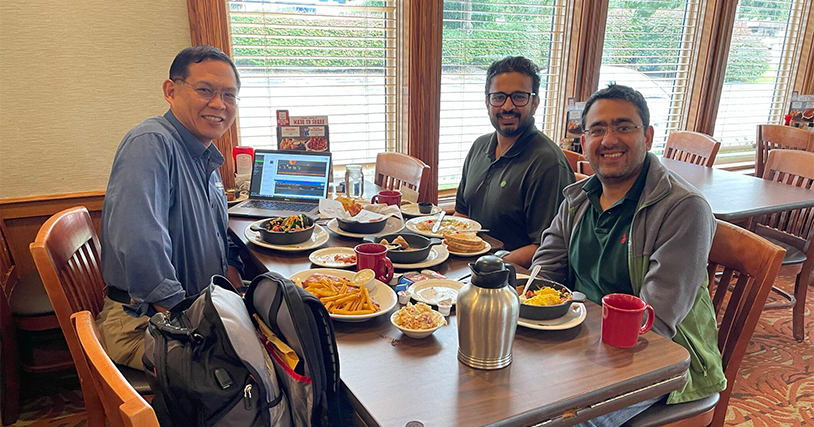
What’s for breakfast at Hughes? Many days, a healthy portion of thought-provoking conversation is served alongside piping hot coffee. Recently, two of my Hughes friends and colleagues Pranav Kondala, senior manager/solutions architect and Akshay Bhat, principal sales engineer/solutions architect, started the day with a wide-ranging discussion. We shared learnings, insights and perspectives on technology in the restaurant industry today based on our individual expertise, conversations with customers and attendance at industry conferences like FSTEC and MURTEC. Here are some highlights.
What is driving restaurant tech?
The labor shortage is prompting restaurants to turn to technologies like Voice Ordering to reduce staffing loads and increase an employee’s ability to engage customers. One example cited at FSTEC was the lone restaurant manager who prepped food and served customers via the drive-thru lane using natural language processing (NLP) Voice Ordering after his front-line employees failed to show up for work. The challenge for an establishment when it comes to Voice Ordering is that the technology can’t work as intended with poor internet service. Restaurants with unstable internet connections need Wide Area Network (WAN) optimization to maintain quality VoIP connections, support cloud-based voice analysis and capture customer orders accurately.
When it comes to technology, is it better to Do it Yourself (DIY) or rely on Managed Services?
The answer depends on a restaurant’s internal capacity. How many technical resources are available in-house? How much work do they already do? While internal resources bring a level of firsthand knowledge about the business and are motivated to provide a high quality of care, those advantages decrease if or when they become overwhelmed. High staff turnover can also introduce long learning curves, training overhead and inefficiencies.
When it comes to technology, is it better to have a “Full Stack” or "Best of Breed" approach?
Enterprises should weigh context and complexity, along with the evolving role of the IT team. Today, IT is moving from being a support function to a business partner. IT is no longer about keeping the lights on, but rather about leveraging tech to drive sales and create a competitive advantage. For a DIY strategy, the Full Stack (in which every element of the solution comes from a single vendor) is easier to manage for smaller IT teams, yet it’s challenging to be the best at everything. For a "Best of Breed" approach (in which each element of the solution is chosen independently based on merits, irrespective of vendor), whether it’s through DIY or a Managed Service Provider (MSP), consider the team’s ability to manage multi-vendor solutions. Do they have the tools required to succeed at multi-vendor orchestration (e.g., dashboards, data strategy, and automation)? Does the team have a proven track-record, or will they encounter a learning curve?
Where will tech make the most impact on business in the near future?
Mobile order-at-table and pay-at-table capabilities give customers more control over the dining experience and increase satisfaction, even with reduced wait staff. Dynamic pricing is also making an impact through its ability to offset the higher cost of goods sold (COGS)—a critical metric that spans a restaurant’s operational and financial performance—and higher labor costs. To implement dynamic pricing effectively, restaurants should integrate both their on-site and online environments. Customers don’t want to see lower pricing on the menu or drive-thru when picking up an order or vice versa. Restaurants can utilize digital menu boards, which aren’t limited to static displays, to update on-site pricing in real-time and then duplicate those changes online for consistency.
These types of conversations—common at Hughes—are invaluable. Through them, we share knowledge, solve challenges, seek advice, keep pace with trends and ultimately serve our customers better.
Go here for more insights, articles and interviews on restaurant technology.